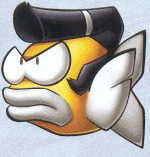Chonmagyo: Difference between revisions
From Starfy Wiki
Jump to navigationJump to search
Torchickens (talk | contribs) No edit summary |
Torchickens (talk | contribs) No edit summary |
||
| Line 19: | Line 19: | ||
==Trivia== | ==Trivia== | ||
===Name origin=== | ===Name origin=== | ||
According to Chonmagyo's [[Toys|Picture Book]] description, its name is a corruption of [[wikipedia:chonmage|chonmage]] (丁髷). The chonmage is a traditional Japanese haircut typically worn by men, which is commonly associated with the [[wikipedia:Edo Period|Edo Period]], [[wikipedia:samurai|samurai]]s and sumo wrestlers. | According to Chonmagyo's [[Toys|Picture Book]] description, its name is a corruption of [[wikipedia:chonmage|chonmage]] (Japanese: 丁髷). The chonmage is a traditional Japanese haircut typically worn by men, which is commonly associated with the [[wikipedia:Edo Period|Edo Period]], [[wikipedia:samurai|samurai]]s and sumo wrestlers. | ||
{{TLS2Navbox}} | {{TLS2Navbox}} | ||
Revision as of 17:33, 20 July 2013
| Chonmagyo | |

| |
| Japanese Name | チョンマギョ, Chonmagyo |
| Leader | Puchi Ogura #10 |
| Affiliates | Echigyoya |
| Located | Torrent's Waterfall |
| First Appearance | Densetsu no Starfy 2 |
| Latest Appearance | Super Smash Bros. Brawl (sticker) |
Chonmagyo are yellow flying fish enemies in Densetsu no Starfy 2. Like Fork, they have events that focus on them, but they are fought like a regular enemy.
In Torrent's Waterfall (Stage 10-1), three Chonmagyo attacked Ogyon before being defeated by Starfy. Despite the small size of the Chonmagyo, they have a bold personality and created various bombs under the command of Puchi Ogura #10.
Chonmagyo appears in Super Smash Bros. Brawl as a sticker that boosts weapon attack by 5.
Trivia
Name origin
According to Chonmagyo's Picture Book description, its name is a corruption of chonmage (Japanese: 丁髷). The chonmage is a traditional Japanese haircut typically worn by men, which is commonly associated with the Edo Period, samurais and sumo wrestlers.

